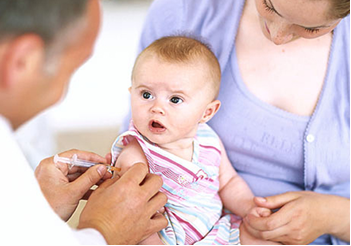Immunization records for your children are important and will be required by schools when you enroll them. The following is the routine immunization list as recommended by the National Advisory Committee on Immunization (NACI):
| Diphtheria, tetanus, acellular pertussis and inactivated polio virus vaccine (DTaP-IPV): DTaP-IPV(± Hib) vaccine is the preferred vaccine for all doses in the vaccination series, including completion of the series in children who have received one or more doses of DPT (whole cell) vaccine (e.g., recent immigrants). In Tables 1 and 2, the 4-6 year dose can be omitted if the fourth dose was given after the fourth birthday.
Haemophilus influenzae type b conjugate vaccine (Hib): the Hib schedule shown is for the Haemophilus b capsular polysaccharide – polyribosylribitol phosphate (PRP) conjugated to tetanus toxoid (PRP-T). For catch up, the number of doses depends on the age at which the schedule is begun (see the Canadian Immunization Guide, Seventh Edition, 2006, Haemophilus Vaccine chapter). Not usually required past age 5 years |
|
| Measles, mumps and rubella vaccine (MMR): a second dose of MMR is recommended for children at least 1 month after the first dose for the purpose of better measles protection. For convenience, options include giving it with the next scheduled vaccination at 18 months of age or at school entry (4-6 years) (depending on the provincial/territorial policy) or at any intervening age that is practical. In the catch-up schedule (Table 2), the first dose should not be given until the child is ≥ 12 months old. MMR should be given to all susceptible adolescents and adults. | |
| Varicella vaccine (Var): children aged 12 months to 12 years should receive one dose of varicella vaccine. Susceptible individuals ≥ 13 years of age should receive two doses at least 28 days apart. | |
| Hepatitis B vaccine (HB): hepatitis B vaccine can be routinely given to infants or pre-adolescents, depending on the provincial/territorial policy. For infants born to chronic carrier mothers, the first dose should be given at birth (with hepatitis B immunoglobulin), otherwise the first dose can be given at 2 months of age to fit more conveniently with other routine infant immunization visits. The second dose should be administered at least 1 month after the first dose, and the third at least 2 months after the second dose, but these may fit more conveniently into the 4 and 6 month immunization visits. A two-dose schedule for adolescents is an option (see the Canadian Immunization Guide, Seventh Edition, 2006, Hepatitis B Vaccine chapter). | |
| Pneumococcal conjugate vaccine – 7-valent (Pneu-C-7): recommended for all children under 2 years of age. The recommended schedule depends on the age of the child when vaccination is begun (see Canadian Immunization Guide, Seventh Edition, 2006, Pneumococcal Vaccine chapter). | |
| Pneumococcal polysaccharide – 23-valent (Pneu-P-23): recommended for all adults ≥ 65 years of age (see the Canadian Immunization Guide, Seventh Edition, 2006, Pneumococcal Vaccine chapter). | |
| Meningococcal C conjugate vaccine (Men-C): recommended for children under 5 years of age, adolescents and young adults. The recommended schedule depends on the age of the individual (see the Canadian Immunization Guide, Seventh Edition, 2006, Meningococcal Vaccine chapter) and the conjugate vaccine used. At least one dose in the pimary infant series should be given after 5 months of age. If the provincial/territorial policy is to give Men-C to persons ≥ 12 months of age, one dose is sufficient. | |
| Diphtheria, tetanus, acellular pertussis vaccine – adult/adolescent formulation (Tdap): a combined adsorbed “adult type” preparation for use in people ≥ 7 years of age, contains less diphtheria toxoid and pertussis antigens than preparations given to younger children and is less likely to cause reactions in older people. | |
| Diphtheria, tetanus vaccine (Td): a combined adsorbed “adult type” preparation for use in people ≥ 7 years of age, contains less diphtheria toxoid antigen than preparations given to younger children and is less likely to cause reactions in older people. It is given to adults not immunized in childhood as the second and third doses of their primary series and subsequent booster doses; Tdap is given only once under these circumstances as it is assumed that previously unimmunized adults will have encountered Bordetella pertussis and have some pre-existing immunity. | |
| Influenza vaccine (Inf): recommended for all children 6-23 months of age and all persons ≥ 65 years of age. Previously unvaccinated children < 9 years of age require two doses of the current season’s vaccine with an interval of at least 4 weeks. The second dose within the same season is not required if the child received one or more doses of Influenza vaccine during the previous Influenza season (see the Canadian Immunization Guide, Seventh Edition, 2006, Influenza Vaccine chapter). | |
| IPV Inactivated polio virus |
Source: Public Health Agency of Canada

